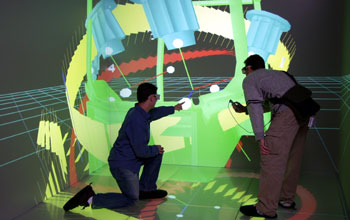Multimedia Gallery
VRSpatial Program
Users of the VRSpatial program at Iowa State University, select a solution from a generated set of fixed and moving congruences. The congruences are sets of lines that define the fixed and moving axes of the joints of a spatial 4C mechanism capable of guiding a body through the four specified design locations in space. They are represented in the design environment by finite-sized red and yellow planes respectively, with every plane representing an infinitely large set of congruence lines parallel to each other. The VRSpatial program is being used to design a spatial 4C linkage in the C6 virtual reality facility.
Motion synthesis of mechanisms relies on the designer's ability to specify desired locations of an object; select a solution; and visualize relative motion of the resultant mechanism. While synthesizing spatial mechanisms, designers specify the problem in 3-D, then select solutions from a 3-D solution set. Virtual reality technology provides a truly 3-D environment in which real-size objects are drawn, and users interact with the objects using natural, 3-D human movement.
This research was supported by a grant from the National Science Foundation's Division of Design and Manufacturing Innovation (DMI 98-72604). (Date of Image: May 29, 2002)
Credit: Judy M. Vance, Virtual Reality Applications Center, Iowa State University
See other images like this on your iPhone or iPad download NSF Science Zone on the Apple App Store.
Special Restrictions: Use of this image is restricted to personal, education or nonprofit/non-commercial use only. Any other use of this image is prohibited.
Images and other media in the National Science Foundation Multimedia Gallery are available for use in print and electronic material by NSF employees, members of the media, university staff, teachers and the general public. All media in the gallery are intended for personal, educational and nonprofit/non-commercial use only.
Images credited to the National Science Foundation, a federal agency, are in the public domain. The images were created by employees of the United States Government as part of their official duties or prepared by contractors as "works for hire" for NSF. You may freely use NSF-credited images and, at your discretion, credit NSF with a "Courtesy: National Science Foundation" notation.
Additional information about general usage can be found in Conditions.
Also Available:
Download the high-resolution JPG version of the image. (1.9 MB)
Use your mouse to right-click (Mac users may need to Ctrl-click) the link above and choose the option that will save the file or target to your computer.



